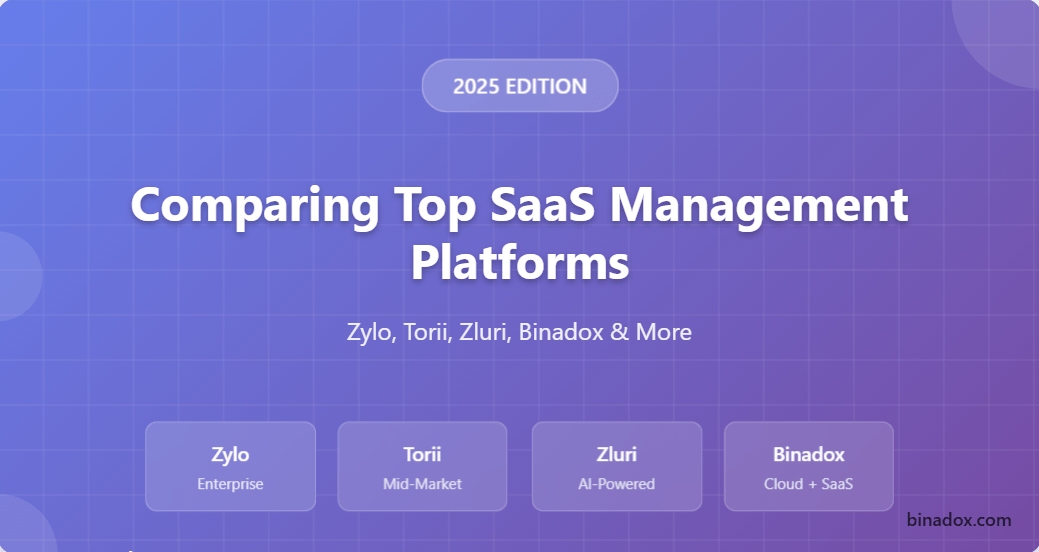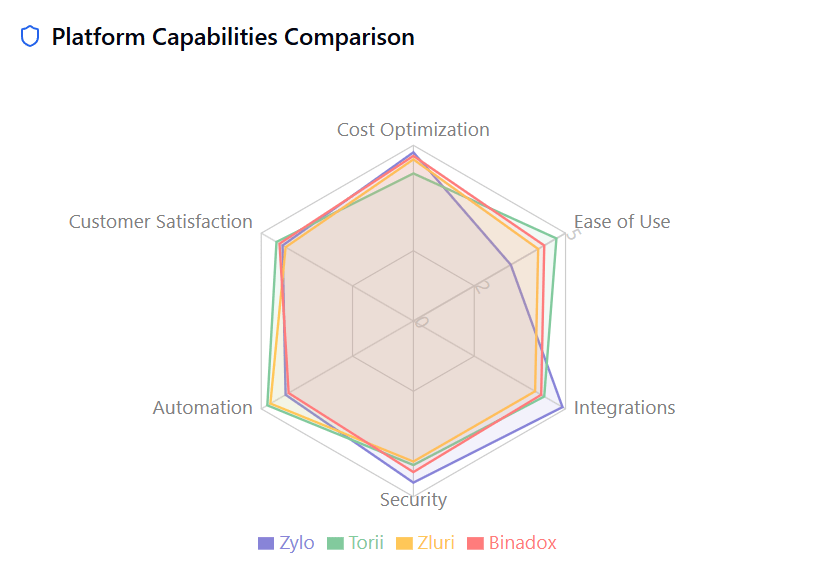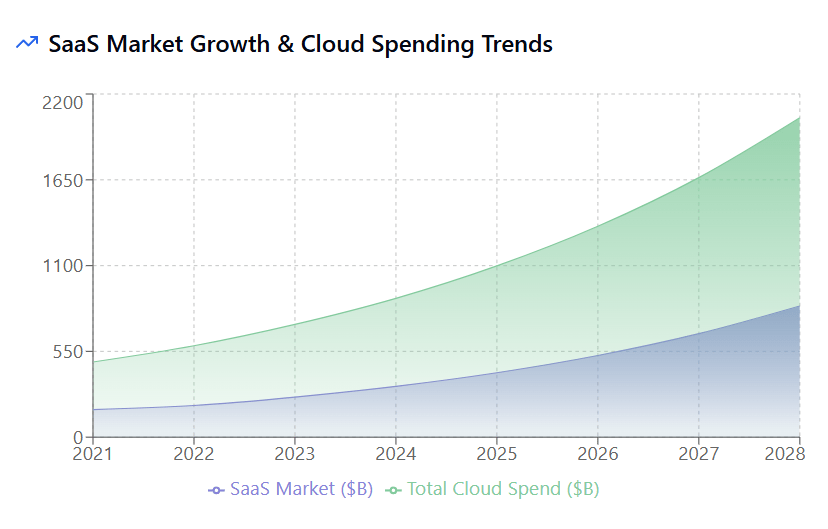
The rapid adoption of Software as a Service (SaaS) applications has transformed how businesses operate, but it has also created new challenges in managing costs, ensuring security, and maintaining visibility across diverse software portfolios. As organizations increasingly rely on affordable SaaS solutions and automated app tracking systems, the need for comprehensive SaaS management platforms has never been more critical.
In 2025, the SaaS management market is experiencing unprecedented growth, with businesses using an average of 80+ applications across their operations. This proliferation has led to significant challenges in controlling SaaS spending, managing user access, and ensuring compliance with security policies. The right SaaS management platform can help organizations achieve centralized app management, implement cost-effective app management strategies, and maintain control over their expanding software ecosystems.
This comprehensive guide examines the leading SaaS management platforms available in 2025, comparing their features, pricing models, integration capabilities, and overall value propositions. Whether you’re looking for budget-friendly SaaS solutions for startups or enterprise-grade platforms for large organizations, this analysis will help you make an informed decision that aligns with your business needs and budget constraints.
What is SaaS Management and Why Does It Matter?
SaaS management encompasses the processes, tools, and strategies organizations use to discover, govern, optimize, and secure their Software as a Service applications. As businesses embrace cloud computing and digital transformation initiatives, SaaS management has evolved from a nice-to-have capability to a business-critical function.
Effective SaaS management addresses several key challenges that modern organizations face:
- Cost Control and Optimization: With SaaS spending often representing a significant portion of IT budgets, organizations need visibility into their software investments to identify redundancies, eliminate unused licenses, and negotiate better terms with vendors. Business software savings can be substantial when organizations implement proper oversight and governance processes.
- Security and Compliance: Each SaaS application introduces potential security risks and compliance considerations. SaaS management platforms help organizations maintain security policies, monitor user access, and ensure that applications meet regulatory requirements across different jurisdictions and industries.
- User Experience and Productivity: Proper SaaS management ensures that employees have access to the tools they need while preventing the frustration and productivity loss associated with poorly managed software portfolios. This includes streamlining onboarding and offboarding processes, managing user permissions, and ensuring application availability.
- Governance and Risk Management: As organizations adopt more SaaS applications, maintaining governance becomes increasingly complex. SaaS management platforms provide the visibility and controls necessary to manage risk, ensure policy compliance, and maintain operational efficiency.
The complexity of managing multiple SaaS applications has led to the emergence of specialized platforms designed to provide centralized visibility and control. These platforms typically offer discovery capabilities to identify shadow IT, spend optimization features to control costs, and governance tools to ensure security and compliance.
Key Features to Look for in SaaS Management Platforms
When evaluating SaaS management platforms, organizations should consider several critical capabilities that distinguish effective solutions from basic monitoring tools:
- Application Discovery and Inventory: The foundation of effective SaaS management is comprehensive visibility into all applications used across the organization. Leading platforms use multiple discovery methods, including network monitoring, financial data integration, and user surveys, to create complete application inventories that capture both sanctioned and shadow IT applications.
- Spend Management and Optimization: Cost control features should include real-time spend tracking, budget alerts, contract management, and optimization recommendations. The best platforms provide actionable insights that help organizations reduce costs through license rightsizing, vendor consolidation, and contract renegotiation opportunities.
- User Access Management: Robust user management capabilities enable organizations to track application usage, manage access permissions, and streamline onboarding and offboarding processes. This includes integration with identity management systems and automated provisioning and deprovisioning workflows.
- Security and Compliance Monitoring: Security features should include risk assessments, compliance tracking, and integration with security tools to provide comprehensive visibility into the security posture of SaaS applications. This includes monitoring for data exposure, ensuring proper authentication mechanisms, and tracking compliance with industry regulations.
- Vendor Management: Effective platforms provide tools for managing vendor relationships, including contract tracking, renewal management, and performance monitoring. This helps organizations maintain better relationships with software vendors while ensuring optimal contract terms and service levels.
- Integration Capabilities: The ability to integrate with existing IT infrastructure, including identity management systems, financial systems, and security tools, is crucial for maximizing the value of SaaS management investments. Look for platforms that offer robust APIs and pre-built integrations with popular enterprise tools.
Top SaaS Management Platforms in 2025
Zylo: Enterprise-Grade SaaS Management
Zylo has established itself as a leader in the enterprise SaaS management space, offering comprehensive visibility and control capabilities designed for large organizations with complex software portfolios.
Key Strengths:
- Advanced discovery capabilities that identify both sanctioned and shadow IT applications
- Sophisticated spend optimization features with detailed cost analysis and recommendations
- Robust integration ecosystem with popular enterprise tools and financial systems
- Strong contract management and vendor relationship tools
- Comprehensive reporting and analytics capabilities
Target Audience: Zylo is best suited for large enterprises with significant SaaS portfolios and dedicated IT teams. The platform’s enterprise focus makes it ideal for organizations that need comprehensive governance capabilities and can justify the investment in advanced features.
Pricing Model: Zylo typically uses custom pricing based on the number of applications and users, with pricing starting in the mid-five figures annually for enterprise deployments.
Integration Capabilities: Zylo offers extensive integration capabilities with major cloud providers, identity management systems, and financial tools, making it suitable for complex enterprise environments.
Torii: User-Friendly SaaS Operations Platform
Torii positions itself as a SaaS operations platform that combines discovery, management, and automation capabilities in a user-friendly interface designed for mid-market organizations.
Key Strengths:
- Intuitive interface that reduces the learning curve for IT teams
- Strong automation capabilities for user provisioning and deprovisioning
- Comprehensive application discovery including shadow IT detection
- Workflow automation for common SaaS management tasks
- Good balance of features and ease of use
Target Audience: Torii is well-suited for mid-market organizations that need comprehensive SaaS management capabilities without the complexity of enterprise-focused platforms. It’s particularly effective for organizations with limited IT resources.
Pricing Model: Torii offers tiered pricing based on the number of managed applications and users, with plans starting in the low four figures annually for smaller deployments.
Integration Capabilities: Torii provides solid integration capabilities with popular SaaS applications and identity management systems, though not as extensive as enterprise-focused competitors.
Zluri: AI-Powered SaaS Management
Zluri differentiates itself through its AI-powered approach to SaaS management, offering intelligent recommendations and automated optimization capabilities.
Key Strengths:
- AI-driven insights and recommendations for cost optimization
- Strong focus on automation and workflow management
- Comprehensive application discovery and inventory management
- Competitive pricing for mid-market organizations
- Growing integration ecosystem
Target Audience: Zluri is ideal for organizations that want to leverage AI and automation to streamline SaaS management processes while maintaining comprehensive visibility and control.
Pricing Model: Zluri offers competitive pricing with transparent tiers based on the number of applications and users, making it accessible to mid-market organizations.
Integration Capabilities: Zluri provides good integration capabilities with popular SaaS applications and is continuously expanding its integration ecosystem.
Binadox: Comprehensive Cloud and SaaS Cost Management
Binadox offers a comprehensive approach to both cloud and SaaS management, providing organizations with unified visibility across their entire cloud and software portfolio.
Key Strengths:
- Combined cloud and SaaS management capabilities in a single platform
- Strong focus on cost optimization and spend management
- Support for multiple cloud providers (AWS, Azure, GCP, DigitalOcean)
- Over 40 SaaS application integrations
- Transparent pricing model not tied to spending volume
- Comprehensive renewal management and license optimization
- Advanced analytics and reporting capabilities
Target Audience: Binadox is particularly well-suited for organizations that want to manage both their cloud infrastructure and SaaS applications from a single platform. It’s ideal for businesses looking for cost-effective app management and comprehensive visibility across their technology stack.
Pricing Model: Binadox offers transparent, volume-independent pricing that makes it accessible to organizations of various sizes, from startups to enterprises.
Integration Capabilities: Binadox provides extensive integration capabilities with major cloud providers and over 40 SaaS applications, including Office 365, Salesforce, Zoom, and others.
Other Notable Platforms
Nudge Security: Focuses primarily on SaaS security and governance, making it ideal for security-conscious organizations that prioritize risk management over cost optimization.
Productiv: Offers strong analytics and insights capabilities, particularly valuable for organizations that want to understand application usage patterns and user engagement metrics.
Nava: Provides a modern approach to SaaS management with strong user experience design and competitive pricing for mid-market organizations.
Detailed Feature Comparison
Discovery and Inventory Management
The ability to discover and maintain an accurate inventory of SaaS applications is fundamental to effective management. Leading platforms use multiple discovery methods to ensure comprehensive coverage:
Automated Discovery: The best platforms combine network monitoring, API integrations, and financial data analysis to automatically identify applications in use across the organization. This includes the ability to detect shadow IT applications that may not have been formally approved or procured.
Manual Discovery: While automation is important, platforms should also provide mechanisms for manual application addition and management, allowing IT teams to capture applications that may not be automatically discoverable.
Inventory Accuracy: Maintaining accurate, up-to-date application inventories requires ongoing monitoring and validation. Look for platforms that provide regular inventory updates and data quality monitoring.
Cost Management and Optimization
Effective cost management goes beyond simple spend tracking to provide actionable insights and optimization recommendations:
Spend Visibility: Platforms should provide comprehensive visibility into SaaS spending across vendors, departments, and time periods. This includes the ability to track both direct and indirect costs associated with SaaS applications.
Budget Management: Look for platforms that support budget creation, tracking, and alerting to help organizations maintain control over SaaS spending and avoid budget overruns.
Optimization Recommendations: The best platforms provide specific, actionable recommendations for reducing costs, such as license rightsizing, vendor consolidation opportunities, and contract renegotiation suggestions.
User and Access Management
Managing user access across multiple SaaS applications is a complex challenge that requires sophisticated tooling:
User Provisioning: Platforms should support automated user provisioning and deprovisioning workflows that integrate with identity management systems to ensure consistent access control.
Access Reviews: Regular access reviews are essential for maintaining security and compliance. Look for platforms that automate access review processes and provide clear visibility into user permissions.
Usage Monitoring: Understanding how users interact with SaaS applications is crucial for optimization and governance. Effective platforms provide detailed usage analytics and reporting.
Security and Compliance
As organizations increase their reliance on SaaS applications, security and compliance become increasingly important:
Risk Assessment: Platforms should provide ongoing risk assessments for SaaS applications, including security posture evaluations and compliance monitoring.
Policy Enforcement: Look for platforms that support policy creation and enforcement, including automated responses to policy violations and risk threshold breaches.
Compliance Reporting: Organizations subject to regulatory requirements need platforms that provide comprehensive compliance reporting and audit trails.

Pricing Models and Total Cost of Ownership
Understanding the true cost of SaaS management platforms requires consideration of both direct licensing costs and implementation expenses:
Licensing Models
Per-Application Pricing: Some platforms charge based on the number of applications being managed. This model can be cost-effective for organizations with smaller SaaS portfolios but may become expensive as application counts grow.
Per-User Pricing: Other platforms use per-user pricing models, which can be more predictable for organizations with stable employee counts but may discourage broader platform adoption.
Flat-Rate Pricing: Some platforms, like Binadox, offer flat-rate pricing that provides predictable costs regardless of usage volume, making budgeting easier and encouraging comprehensive adoption.
Implementation and Ongoing Costs
Professional Services: Many platforms require professional services for implementation and configuration. Consider these costs when evaluating total cost of ownership.
Training and Adoption: The complexity of the platform will impact training requirements and adoption costs. More intuitive platforms may require less investment in training and change management.
Integration Costs: Custom integrations and API development may be required for some platforms, adding to the total implementation cost.
Integration Capabilities and Ecosystem
The value of a SaaS management platform is significantly enhanced by its ability to integrate with existing systems and processes:
Identity Management Integration
Integration with identity management systems is crucial for automating user provisioning and ensuring consistent access control across SaaS applications. Look for platforms that support:
- Single sign-on (SSO) integration
- Automated provisioning and deprovisioning
- Role-based access control
- Multi-factor authentication support
Financial System Integration
To provide accurate cost tracking and budgeting capabilities, platforms should integrate with financial systems including:
- Accounts payable systems
- Procurement platforms
- Expense management tools
- Enterprise resource planning (ERP) systems
Security Tool Integration
For comprehensive security management, platforms should integrate with existing security tools such as:
- Security information and event management (SIEM) systems
- Vulnerability management platforms
- Cloud access security brokers (CASBs)
- Data loss prevention (DLP) tools
Implementation Best Practices
Successfully implementing a SaaS management platform requires careful planning and execution:
Discovery and Inventory Phase
Start with comprehensive discovery to establish a baseline understanding of your current SaaS portfolio. This includes:
- Automated discovery using network monitoring and financial data analysis
- Manual surveys to capture shadow IT applications
- Integration with existing asset management systems
- Validation of discovery results with business stakeholders
Governance Framework Development
Establish clear governance policies and procedures before rolling out the platform:
- Define approval processes for new SaaS applications
- Establish cost management policies and budget allocation
- Create security and compliance standards
- Develop user access management procedures
Phased Rollout
Consider a phased rollout approach that allows for learning and refinement:
- Start with a pilot group to validate platform configuration
- Gradually expand to additional departments or business units
- Incorporate feedback and lessons learned into the broader rollout
- Provide ongoing training and support for platform users

Future Trends in SaaS Management
The SaaS management landscape continues to evolve, with several trends shaping the future of the market:
Artificial Intelligence and Machine Learning
AI and ML technologies are increasingly being integrated into SaaS management platforms to provide:
- Intelligent cost optimization recommendations
- Automated risk assessment and security monitoring
- Predictive analytics for usage and spending patterns
- Natural language interfaces for platform interaction
Integration with Cloud Management
As organizations adopt multi-cloud strategies, the line between SaaS and cloud management is blurring. Future platforms will likely provide unified management capabilities across cloud computing infrastructure and SaaS applications.
Enhanced Automation
Automation capabilities will continue to expand, including:
- Automated policy enforcement and remediation
- Intelligent user provisioning based on role and department
- Automated vendor management and contract optimization
- Self-service capabilities for end users
Making the Right Choice for Your Organization
Selecting the right SaaS management platform requires careful consideration of your organization’s specific needs, constraints, and objectives:
Organizational Size and Complexity
- Small to Mid-Size Organizations: Look for platforms that offer good value and ease of use without overwhelming complexity. Platforms like Binadox, Torii, or Zluri may be good fits.
- Large Enterprises: Consider platforms with comprehensive governance capabilities and extensive integration ecosystems, such as Zylo or enterprise versions of other platforms.
Primary Use Cases
- Cost Optimization Focus: If cost control is the primary driver, look for platforms with strong spend management and optimization capabilities.
- Security and Compliance Focus: For security-conscious organizations, prioritize platforms with comprehensive risk assessment and compliance features.
- Operational Efficiency Focus: If streamlining operations is the goal, look for platforms with strong automation and workflow capabilities.
Budget Considerations
Consider both upfront and ongoing costs, including:
- Platform licensing fees
- Implementation and professional services costs
- Training and change management expenses
- Integration and customization costs
Integration Requirements
Evaluate the platform’s ability to integrate with your existing systems:
- Identity management systems
- Financial and procurement tools
- Security and monitoring platforms
- Existing SaaS applications
Conclusion
The SaaS management platform market in 2025 offers organizations a diverse range of solutions designed to address the challenges of managing increasingly complex software portfolios. From enterprise-focused platforms like Zylo to AI-powered solutions like Zluri, and comprehensive cloud and SaaS management platforms like Binadox, organizations have numerous options to choose from.
The key to success lies in understanding your organization’s specific needs and selecting a platform that aligns with your objectives, budget, and technical requirements. Whether you’re looking for affordable SaaS solutions for a growing startup or comprehensive enterprise-grade capabilities for a large organization, the platforms examined in this guide offer proven approaches to SaaS management challenges.
As the SaaS ecosystem continues to evolve, organizations that invest in proper management capabilities will be better positioned to maximize the value of their software investments while maintaining security, compliance, and cost control. The platforms discussed in this guide represent the current state of the art in SaaS management, each offering unique strengths and capabilities that can help organizations navigate the complexities of modern software portfolios.
By implementing effective SaaS management practices and selecting the right platform for your needs, your organization can achieve better cost control, improved security posture, and enhanced operational efficiency in an increasingly software-driven business environment. The investment in proper SaaS management will pay dividends through reduced costs, improved productivity, and better risk management across your entire technology stack.

